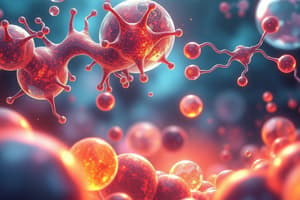Podcast
Questions and Answers
What is pharmacodynamics primarily concerned with?
What is pharmacodynamics primarily concerned with?
- The cost of drug development
- The chemical composition of drugs
- How drugs affect biological systems (correct)
- How drugs are absorbed by the body
Which route of administration is characterized by direct delivery into the bloodstream?
Which route of administration is characterized by direct delivery into the bloodstream?
- Topical
- Oral
- Intramuscular
- Intravenous (correct)
Which type of drug classification refers to drugs that block receptors?
Which type of drug classification refers to drugs that block receptors?
- Agonists
- Analgesics
- Enzyme inhibitors
- Antagonists (correct)
What is the first step in the drug development process?
What is the first step in the drug development process?
Which of the following is considered a severe adverse drug reaction (ADR)?
Which of the following is considered a severe adverse drug reaction (ADR)?
What does the therapeutic index indicate?
What does the therapeutic index indicate?
Which factor does NOT influence adverse drug reactions (ADRs)?
Which factor does NOT influence adverse drug reactions (ADRs)?
What term describes the fraction of an administered drug that reaches systemic circulation?
What term describes the fraction of an administered drug that reaches systemic circulation?
Study Notes
Definition
- Pharmacology: The study of drugs and their effects on biological systems.
Key Concepts
-
Pharmacodynamics: The study of how drugs affect the body.
- Mechanism of action
- Dose-response relationships
- Therapeutic vs. toxic effects
-
Pharmacokinetics: The study of how the body affects drugs.
- Absorption
- Distribution
- Metabolism (biotransformation)
- Excretion
-
Routes of Administration:
- Oral (PO)
- Intravenous (IV)
- Intramuscular (IM)
- Subcutaneous (SC)
- Inhalation
- Topical
Drug Classification
-
By Origin:
- Natural (plants, animals)
- Synthetic (chemically manufactured)
-
By Mechanism of Action:
- Agonists (activate receptors)
- Antagonists (block receptors)
- Enzyme inhibitors
-
By Therapeutic Use:
- Antibiotics
- Analgesics
- Antidepressants
- Antihypertensives
Drug Development Process
- Discovery and Development: Identifying potential drug candidates.
- Preclinical Testing: Laboratory and animal testing for safety and efficacy.
- Clinical Trials: Phases I (safety), II (efficacy), III (comparison to standard), IV (post-marketing).
- Regulatory Approval: Submission to authorities (e.g., FDA) for market authorization.
Adverse Drug Reactions (ADRs)
- Types:
- Mild (nausea, headache)
- Severe (anaphylaxis, organ failure)
- Factors Influencing ADRs:
- Age, sex, genetics, concurrent medications
Drug Interactions
- Types:
- Pharmacodynamic (combined effects)
- Pharmacokinetic (altered absorption/metabolism)
- Examples:
- Synergistic effects (enhanced effect)
- Antagonistic effects (reduced effect)
Important Terms
- Bioavailability: The fraction of an administered drug that reaches systemic circulation.
- Half-life: Time taken for the plasma concentration of a drug to reduce to half its initial value.
- Therapeutic Index: Ratio of the toxic dose to the therapeutic dose; indicates drug safety.
Current Trends
- Personalized medicine: Tailoring drug therapy based on individual genetic profiles.
- Biologics: Complex drugs derived from living organisms.
- Pharmacogenomics: Study of how genes affect individual responses to drugs.
Definition
- Pharmacology encompasses the study of drugs and their effects on biological systems.
Key Concepts
-
Pharmacodynamics
- Examines how drugs interact with the body.
- Involves understanding mechanism of action, dose-response relationships, and distinguishing therapeutic effects from toxic effects.
-
Pharmacokinetics
- Investigates how the body processes drugs.
- Key processes include absorption, distribution, metabolism (biotransformation), and excretion.
-
Routes of Administration
- Various methods include oral (PO), intravenous (IV), intramuscular (IM), subcutaneous (SC), inhalation, and topical routes.
Drug Classification
-
By Origin
- Natural drugs are derived from plants and animals, while synthetic drugs are chemically manufactured.
-
By Mechanism of Action
- Drugs can be classified as agonists (activate receptors), antagonists (block receptors), or enzyme inhibitors.
-
By Therapeutic Use
- Categories include antibiotics (fight infections), analgesics (pain relief), antidepressants (treat mood disorders), and antihypertensives (manage blood pressure).
Drug Development Process
- Discovery phase involves identifying potential drug candidates.
- Preclinical testing focuses on laboratory and animal studies to assess safety and efficacy.
- Clinical trials progress through four phases: Phase I (safety), Phase II (efficacy), Phase III (comparison to standard treatment), Phase IV (post-marketing surveillance).
- Regulatory approval requires submission to authorities like the FDA for market authorization.
Adverse Drug Reactions (ADRs)
-
Types of ADRs
- Mild reactions include nausea and headache, while severe reactions can lead to anaphylaxis or organ failure.
-
Factors Influencing ADRs
- Age, sex, genetics, and concurrent medications can all impact the occurrence of ADRs.
Drug Interactions
-
Types of Interactions
- Pharmacodynamic interactions involve combined effects of drugs, while pharmacokinetic interactions alter absorption and metabolism.
-
Examples of Interactions
- Synergistic effects enhance drug effectiveness, whereas antagonistic effects reduce the overall impact.
Important Terms
-
Bioavailability
- Refers to the portion of a drug that enters systemic circulation after administration.
-
Half-life
- Defines the time needed for a drug's plasma concentration to decrease by half.
-
Therapeutic Index
- Represents the safety margin of a drug, indicated by the ratio of toxic dose to therapeutic dose.
Current Trends
- Personalized medicine focuses on customizing drug therapies based on individual genetic profiles.
- Biologics are complex pharmaceuticals derived from living organisms.
- Pharmacogenomics explores the relationship between genetics and individual responses to drug treatments.
Studying That Suits You
Use AI to generate personalized quizzes and flashcards to suit your learning preferences.
Description
Explore the essential principles of pharmacology, including pharmacodynamics and pharmacokinetics. This quiz covers drug classifications, routes of administration, and the drug development process, providing a comprehensive understanding of how drugs interact with biological systems.




